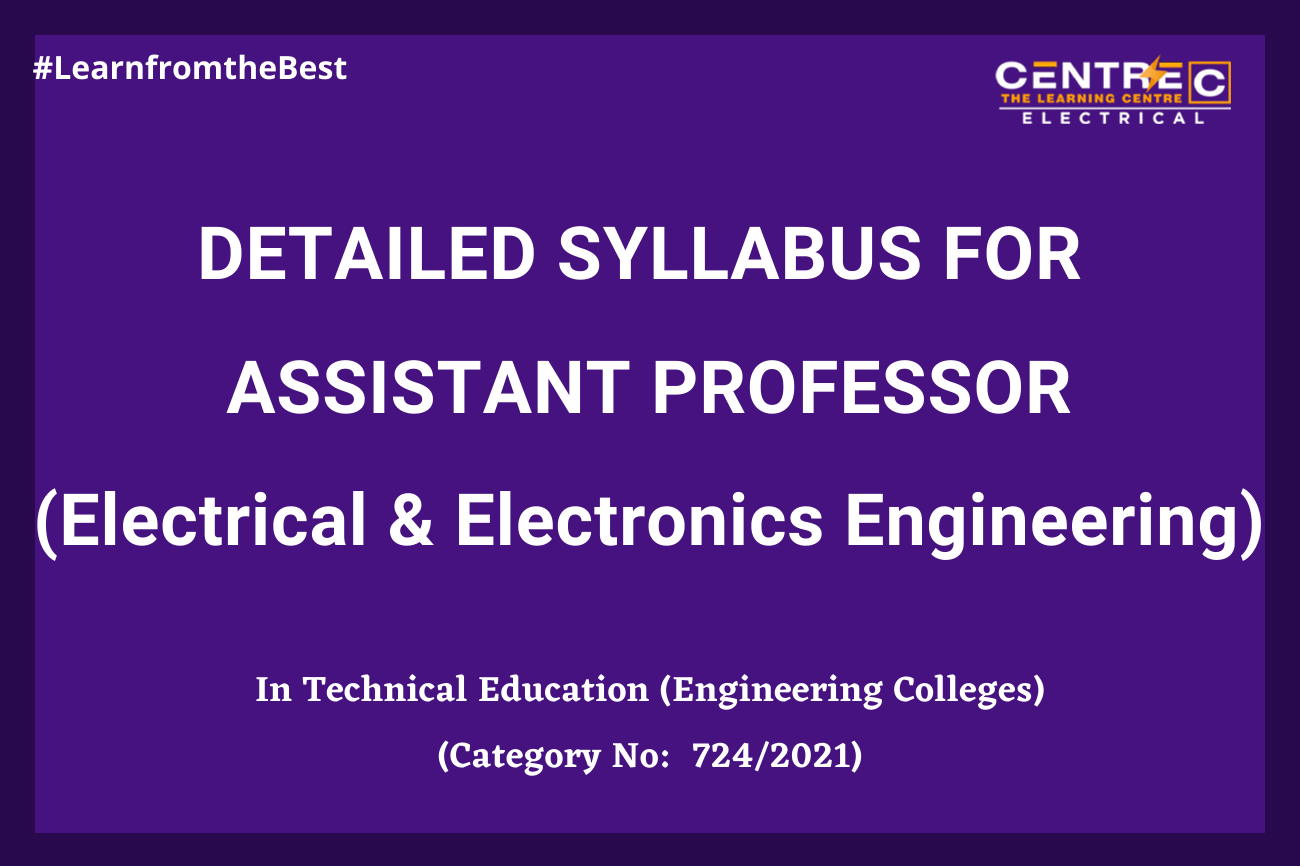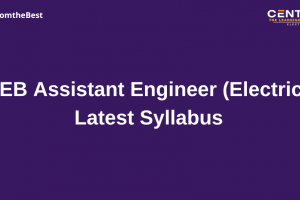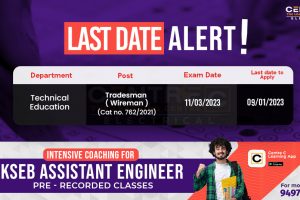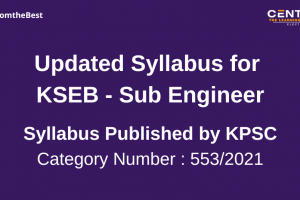
Syllabus: Assistant Professor – Electrical & Electronics Engineering
Detailed Syllabus for Assistant Professor – Electrical & Electronics Engineering
(Category No. 724/2021)
Module I :
a) MATHEMATICS (ENGINEERING)
Matrices: Rank, systems of linear equations, consistency, eigen values, eigen vectors, Cayley Hamilton Theorem, diagonalization, linear dependence and independence of vectors.
Partial Differentiation: Partial derivatives, Euler’s theorem on homogeneous functions, total derivatives, Jacobians, Taylor’s series (one and two variables) – Maxima and minima of functions of two variables – Lagrange’ s method.
Vector Differentiation: Scalar and vector functions, differentiation of vector functions – velocity and acceleration – scalar and vector fields – operator – Gradient – Directional derivative – Divergence – Curl – irrotational and solenoidal
fields – scalar potential.
Laplace Transforms: Transforms of elementary functions, shifting property – inverse transforms – transforms of derivatives and integrals – transform of functions multiplied by t and divided by t – convolution theorem, solution of ordinary differential equations with constant coefficients using Laplace transforms.
Ordinary Differential Equations: First Order ordinary differential equations, systems of linear first order ordinary differential equations, linear ordinary differential equations of higher order with constant coefficients, linear second order ordinary differential equations with variable coefficients (Cauchy and Legendre equations), Method of Laplace transforms for solving ordinary differential equations.
Complex Analysis: Analytic functions, conformal mappings, bilinear transformations, complex integration, Cauchy’s integral theorem and formula, Taylor and Laurent’s series, residue theorem.
Fourier Series: Fourier series of periodic functions of period 2 π and 2 ℓ, odd and even functions, Half range expansions.
b) BASIC CIVIL ENGINEEERING
Mechanics – statistics – Coplanar forces – conditions of equilibrium. Support reactions – Simply supported and overhanging beams. Friction – Laws of friction – applications. Centre of gravity and moment of inertia of plane areas. Dynamics – rectilinear motion – Newton’s laws of motion – curvilinear motion.
Building materials – common building materials – stone, brick, cement, steel, aggregate, concrete, timber – properties, IS specification. Building construction – types and functions of the following structural components of buildings – foundations and superstructure.
Surveying – principle of surveying – linear measurements using chain – levelling work – reduction of levels.
c) BASIC MECHANICAL ENGINEERING
Zeroth, first and second laws of thermodynamics, CI and SI Engines, properties of steam. Centrifugal and reciprocating pumps, hydraulic turbines, refrigeration and air conditioning, hydro-electric, thermal and nuclear power plants, mechanical power transmission systems such as belt, rope, chain and gear, manufacturing process – casting, forging, rolling, brazing, soldering, and welding, machining process – turning, shaping, drilling, grinding and milling. Conic sections and miscellaneous curves, orthographic, isometric and perspective projections.
Module II :
a) BASIC ELECTRICAL ENGINEERING
Ohm’s law, Kirchoff’s laws – solution of series and parallel circuits with dc excitation.
Magnetic circuits: MMF, field strength, flux density, reluctance, electromagnetic induction, Faraday’s laws, Lenz’s law, statically and dynamically induced emfs, self and mutual induction, co-efficient of coupling.
Principle of generation of alternating current – waveforms – frequency, period, average and rms values, form factor.
Generation of 3 phase ac voltage, star and delta connections, voltage & current relationships in star and delta (balanced system only).
Principle of operation of dc motor & generator, single phase transformer and three phase induction motor. Types of lamps, necessity of earthing.
b) BASIC ELECTRONICS ENGINEERING
Devices – working principle of PN junction, Zener diode and BJT.
Systems – Rectifiers : Half wave, Full wave and Bridge. Filters: Capacitors and Inductors.
Amplifiers & Oscillators – Common Emitter RC coupled amplifier and its frequency response. Principles of Wein-bridge oscillator. Op-amps: Basics, inverting and non-inverting amplifier.
Communication – Need for modulation, principles of AM and FM.
Measurements – Working principles of CRO and Multimeter.
c) BASIC COMPUTER SCIENCE
Functional units of a computer.
Programming in C – control structures, functions.
Module III :
Electronic Circuits and Field Theory:
Node and Mesh analysis, transient response of dc and ac networks, sinusoidal steady state analysis, resonance, two port network, independent and dependent voltage and current sources, coupled circuits, tuned coupled circuits, Network theorems – superposition, reciprocity, substitution, compensation, Thevenin, Norton, Millman, Telligen and Maximum power transfer theorems. Analysis of Three phase circuits, symmetrical components, graph theory – analysis of network using cut-set and tri-set. Filters constant – K low pass, high pass and band-pass filters – m derived, low pass,
high pass and band pass filters.
Gauss’s law and applications, electric field, electric potential, electric field lines, electric dipoles, potential gradient, conductors, dielectrics, capacitance, polarisation, method of images, dielectric strength, Biot-Savart’s law, Ampere’s circuital law, Stoke’s theorem, scalar and vector magnetic potential, force between current carrying wires, Maxwell’s equation – wave equation – Poynting theorem.
Module IV :
Electrical Machines:
Single phase Transformer – leakage reactance, equivalent circuit, losses and efficiency, voltage regulation, OC, SC and Sumpner’s tests, Distribution transformer, all day efficiency, autotransformer – saving of copper three phase transformer – connections, vector groupings, parallel operation.
DC machines – Types of excitation, constructional features.
DC generator – Emf equation, armature reaction & commutation, characteristics, voltage build up, applications.
DC motor – Torque equation, characteristics of shunt, series & compound motors, necessity & types of starters, speed control, applications, Swinburne’s test, Hopkinson’s test.
Synchronous machines: – constructional features, winding factor. Alternator: Types, synchronous reactance, voltage regulation, emf and mmf methods, short circuit ratio, Two reaction theory, alternator on infinite bus, power angle characteristics, parallel operation, effect of variation of power input & excitation.
Synchronous motor – principle of operation, methods of starting, hunting & its reduction.
Three phase induction motor – constructional features, types, slip rotor frequency, power flow, Torque – slip curve, effect of rotor resistance, starting methods, speed control.
Single phase induction motor – double field revolving theory, starting methods.
Basic concepts of ac and dc drives.
Module V :
Power Systems:
Conventional and non-conventional systems of power generation, power plant economics, load factor, demand factor, diversity factor, Transmission line parameters – T and ∏ models GMD and GMR, ABCD constants, overload lines – arrangement of conductors – sag, economic span, choice of transmission voltage, types of insulators, string efficiency, distribution systems – types, comparison of DC and AC single phase and 3 phase systems.
One line diagrams per unit quantities, formation of Y bus and Z Bus. Load flow studies – Gauss – Seidal, Newton Raphson and Fast decoupled load flow methods.
Faults on power systems – LG, LL, LLG and 3 phase faults. Fault analysis using Z Bus.
Power system stability, steady state transient and dynamic stability, equal area criterion, swing curve.
Protective relays: types and operation, protective zones, different protection schemes.
Circuit Breakers – types and operations, selection of circuit breakers, calculation of fault KVA, protection against lightning and overvoltages.
Electric traction – speed – time curves – mechanics
Electric heating – Advantages, types and applications.
Principles of PMMC, moving iron, and electrodynamometer type instruments, error analysis, measurement of voltage, current, power energy and power factor, induction type watt-hour meter, DC bridges and AC bridges, magnetic measurements, Instrument transformers, digital voltmeters and multimeters, digital measurements of frequency, phase angle, time interval.
Electronic energy meter, high voltage measurements, oscilloscopes, Data acquisition systems, Transducers for temperature, flow and pressure.
Module VI :
Control Systems:
Open loop and closed loop system: Transfer function, force-voltage & force-current analogy, block diagrams, signal flow graphs – Mason’s gain formula – characteristic equation, time domain analysis – transient & steady state responses – time domain specifications & steady state error.
Concept of stability – Routh’s stability criterion – Root locus – effect of addition of poles and zeros.
Frequency domain analysis – Nyquist & Bode plots, gain margins and phase margin, lag, lead and lag-lead compensators and their design using Bode plot.
State space analysis of system: State space models, state transition matrix, relationship between state equations and transfer function, controllability and observability.
Nonlinear system: – characteristics, types of non-linearities, describing functions analysis – concept, singular points – focus, centre, node and saddle points – limit cycle. Types of signals and systems, sampling process, sampling theorem, convolution of discrete time signals, analysis of LTI systems using Z transforms. DFT and FFT, Types of digital filters.
Module VII :
Electronics:
BJT and FET amplifiers – biasing circuits, types of amplifiers, low frequency and high frequency considerations. Oscillators and feedback amplifiers, operational amplifier circuits and applications – simple active filters. VCO’s and timers. Voltage
regulators using linear IC’s, combinational and sequential logic circuits – flip flops, counters, shift registers, TTL & CMOS logic families, memories – ROM, PROM, EPROM & RAM.
Schmitt trigger, multivibrators, sample and hold circuits, A to D and D to A converters, 8 bit and 16 bit microprocessor basics, architecture, programming and interfacing.
Thyristors, triacs, GTO’s MOSFETS & IGBTS – principles of operation, triggering circuits, phase control rectifiers, bridge converters – fully controlled and half controlled, Inverters and choppers.

CENTRE C ELECTRICAL SOCIAL MEDIA PLATFORMS
Our Social media platforms are exclusively for Electrical Engineering students, job candidates, teachers and all those who have passion for Electrical Engineering.
You will get
- Electrical engineering quiz
- Regular job notifications
- Exam notifications
- E – News
- E – Shots
- Study tips
- Electrical related discussion and all in this group.




